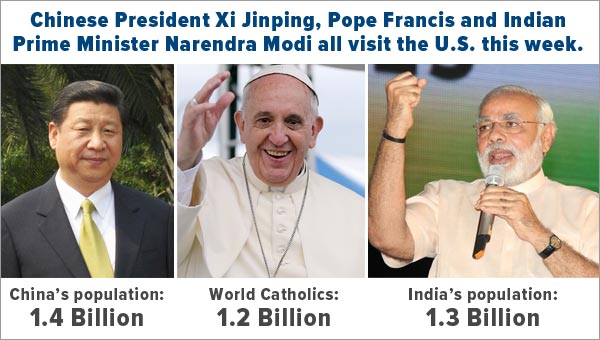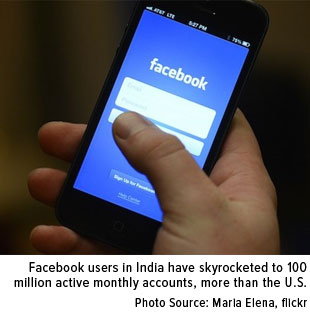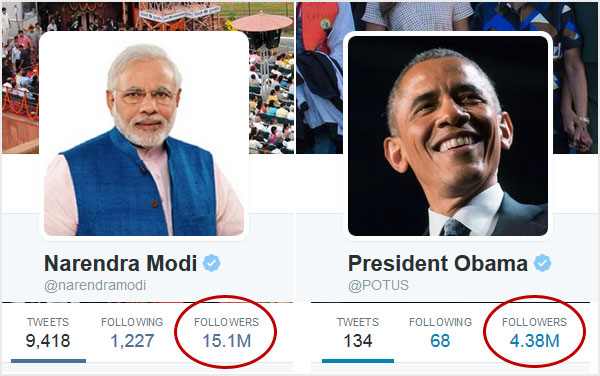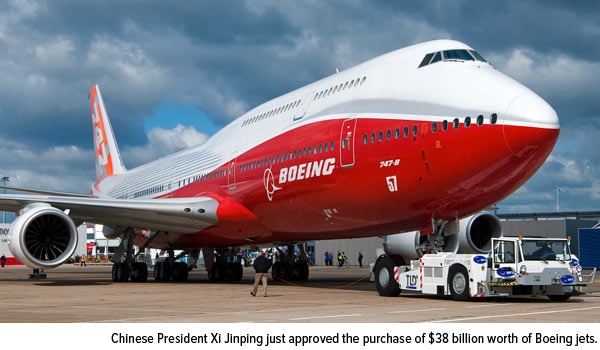Last week the U.S. played host to three prominent and illustrious leaders to billions of people: Chinese President Xi Jinping, Indian Prime Minister Narendra Modi and Pope Francis. Among them, they lead—either politically or spiritually—nearly 4 billion people worldwide, more than half of everyone living on the planet right now.

The effect of their visits cannot be overstated. I was attending an ETF conference in New York City, where the arrival of the populist Francis, hugely popular and revered among more than just Catholics for his humility and inclusiveness, brought the already-clogged city streets to a veritable standstill. So stacked were the cars and trucks as a result of Pope Mania that I was forced to cancel scheduled interviews on CNBC and Bloomberg. New York Police Department Commissioner Bill Bratton said that the pontiff’s arrival in the Big Apple during the United Nations General Assembly—when 90 percent of the world leaders were in the city at the same time—was the largest security challenge the department and city had ever faced.
I have immense respect for his Holy One. He embraces change, both within the Vatican and globally, and for the Jesuit tradition of education and ministry.
For many people, including me, Pope Francis is a thought-provoking figure. In his speech to the United Nations last week, he said that economic progress can be achieved through “the legitimate redistribution of economic benefits by the state.” I question his economic logic while admiring his caring heart and good intentions. Far-reaching progress can best be achieved through development, not redistribution. The secular proverb “Give a man a fish and he’ll eat for a day, but teach him to fish and he’ll eat for a lifetime” comes to my mind.
Certainly the pontiff’s aspiration to feed the world is honorable, but the people who take the risk to plant the seeds and work hard to harvest the crops are not to blame for the hungers that exist. America is the most charitable nation on earth and our focus for increasing prosperity should be on helping people to fish and farm for a lifetime of financial independence.
Perhaps not as wildly anticipated, but no less important, were stateside visits from the heads of the second- and seventh-largest economies in the world, China and India.
Mr. Xi: Trust Me, All’s Well
In his first stateside visit, President Xi Jinping addressed approximately 700 American businesspeople in Seattle last week, during which he, according to Foreign Policy magazine , touched on “the usual promises to stay the course on market reforms, the insistence of China’s status as a developing country” and “the plea for mutual ‘deep’ cultural understanding,” among other promises.
Mr. Xi also reassured his audience to worry not about the Chinese stock market, which I’ve written frequently about . He defended the intervention his government has made, arguing that the government has stabilized further deterioration and contained investor panic.
Likewise, he pledged to work with the U.S. to curb additional cybersecurity breaches such as the kind that struck Sony Pictures back in November 2014.
American Business Leaders Expect Massive Growth in India
Last week marked Indian Prime Minister Narendra Modi’s second visit to the U.S., the first time being in October 2014 when he spoke at Madison Square Gardens in a rousing, rock-star reception.
As is the case with most politicians from whom much is expected, Modi’s star has dulled somewhat since then. Many business leaders are starting to grow impatient about the slowness of his government’s ability to eliminate investment hurdles.
But the promise he brings of a modern India, with electricity and Internet access for all 1.2 billion Indians, still remains more than just a dream.
U.S. business leaders seek to capitalize on this growth.

Let’s be clear, though: India still has a lot of catching up to do. Morgan Stanley estimates that the country is at least seven years behind China when it comes to Internet penetration and online shopping. In 2014, India had about 243 million active Internet users, or about 19 percent of its population. In the same year, China had some 641 million users, or nearly half of its population, according to Internet Live Stats .
Quite contradictorily, though, Facebook users in India have skyrocketed to 100 million active monthly accounts , which represent a larger presence on the social media platform than in the U.S, according to Tech2. This means there’s huge upside indeed.
Modi: Tech-in-Chief
Narendra Modi is one of the most tech-savvy world leaders, a characteristic he wants to encourage his fellow Indians to embrace. He’s a prolific user of Twitter, followed by a staggering 15.1 million people. By comparison, President Barack Obama’s official presidential Twitter handle, @POTUS, has 4.38 million followers while @Pontifex, Pope Francis’ Twitter handle, has 7.35 million followers.

It’s no wonder, then, that Modi sought an audience with top tech industry leaders such as Facebook founder and CEO Mark Zuckerberg, Apple CEO Tim Cook and Tesla Motors CEO Elon Musk—some of the same figures Mr. Xi met with earlier in the week. All of them have expressed interest in diverting more resources to India, where the next huge surge in Internet usage is expected to take place. Retail giant Amazon, for instance, plans to spend $2 billion to expand its presence in India. Facebook will offer a free Internet service through its Internet.org platform.
In a YouTube video, Sundar Pichai, Google’s current Product Chief and its next CEO, welcomed Modi on his visit to immigrant-friendly Silicon Valley . Born in India himself, Pichai highlighted the strong, longstanding partnership between Indian and America’s major tech hub, stating:
The bond between India and Silicon Valley is strong. India’s long been an exporter or talented tech companies… The products by Indian graduates have helped revolutionize the world, but it is India that’s now undergoing its own revolution… Prime Minister Modi’s digital India vision is central to the revolution. It focused on connecting the 1.2 billion people in India.
You can watch Pichai’s full comments below.
In his personal tweets, Modi reassures followers that the goal of his visit is to strengthen business relations between the U.S. and India and to open his country up to further investment opportunities. This is a persistent challenge, as India is widely seen as one of the more difficult countries to conduct business in.
Modi has repeatedly pledged to speed up efforts to improve his country’s business climate for foreign investors.

In the picture above, you can see a seated Modi surrounded by powerful Fortune 500 executives such as Citigroup’s Michael O’Neill, PepsiCo’s Indra Nooyi, IBM’s Ginni Rometty, Lockheed Martin’s Marilyn Hewson, Boeing’s Bertrand-Marc Allen and many more.
During his visit, Modi approved a $3 billion deal with Boeing—which we own in both our All American Equity Fund (GBTFX) and Holmes Macro Trends Fund (MEGAX) —a purchase that’s eclipsed by Xi Jinping’s plan to buy 300 Boeing jets worth $38 billion, not to mention an arrangement for an assembly plant to be built in China.

In our quarterly earnings webcast , I mentioned the importance of staying abreast of government policy changes and the latest purchasing manager’s index (PMI) numbers. While India’s August PMI reading holds fairly steady at 52.3, indicating manufacturing expansion, China’s still remains in contraction territory at 47.3.
Both government policy reform and PMIs help our investment team inform its strategies. Government policy, as led by the G20 countries, has unfortunately been focused largely on synchronized global taxation and regulation since 2008. These are not great precursors for commodity demand.
When we can return to a point where governments are more focused on fiscal policies, reducing taxes, streamlining regulations and unleashing capital, I think that that would be a tipping point from a big macro sector theme.
So shorter term, we’ll be looking for the change in global PMIs, which would indicate global synchronized growth. The “magic” number is when PMI is above 50, and the momentum starts when the one month crosses above the three months. This is the positive, constructive sign that demand for commodities is picking up, and we’ll be looking for it.



